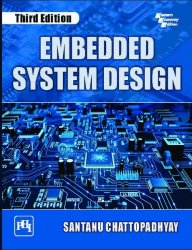Embedded System Design, 3rd Edition
- Добавил: literator
- Дата: 26-04-2024, 18:36
- Комментариев: 0
 Название: Embedded System Design, 3rd Edition
Название: Embedded System Design, 3rd EditionАвтор: Santanu Chattopadhyay
Издательство: PHI Learning Private Limited
Год: 2023
Страниц: 277
Язык: английский
Формат: pdf (true)
Размер: 23.7 MB
Embedded system, as a subject, is an amalgamation of different domains, such as digital design, architecture, operating systems, interfaces, and algorithmic optimization techniques. This book acquaints the students with the alternatives and intricacies of embedded system design. It is designed as a textbook for the undergraduate students of Electronics and Communication Engineering, Electronics and Instrumentation Engineering, Computer Science and Engineering, Information Communication Technology (ICT), as well as for the postgraduate students of Computer Applications (MCA). While in the hardware platform the book explains the role of microcontrollers and introduces one of the most widely used embedded processors, ARM; it also deliberates on other alternatives, DSP, FPD and IC. It provides a good overview of the interfacing standards covering RS232C, RS422, RS485, USB, IrDA, Bluetooth, and CAN. In the software domain, the book introduces the features of real-time operating systems for use in embedded applications. Various scheduling algorithms have been discussed with their merits and demerits. The existing real-time operating systems have been surveyed. Guided by cost and performance requirements, embedded applications are often implemented partly in hardware and partly in software. This book covers the different optimization techniques proposed in the literature to take a judicious decision about this partitioning of application tasks. Power-aware design of embedded systems has also been dealt with.
Embedded Systems are foreseen to be present in almost every electrical/electronic system, in the form of computing engine embodied within them, often unnoticed by the users of the systems. Because of this, the future electronic engineers need to be equipped with the design methodology of such systems. Expertise in just only one or few domains, such as hardware, software, networking, etc. may not be sufficient to enable the designer to take wise decisions regarding the implementation platforms and design techniques to be utilized for cost‑effective solutions to the design problems. An overall knowledge of all the fields with pros and cons of design alternatives is essential for designing such systems. As a subject, embedded system is an amalgamation of the fields, such as computer architecture, operating systems, modelling real-world environment, interfacing standards, networking, algorithms, and so on.
Key Features: • Presents a considerably wide range of the field of embedded systems • Discusses the ARM microcontroller in detail • Enumerates various sensors and actuators used in embedded system design • Provides numerous exercises to assess the learning process • Offers a good discussion on hardware–software codesign • Provides a detailed study on security aspects of embedded systems NEW TO THE EDITION The new edition introduces: • Two new chapters—Sensors and Actuators, and Security in Embedded Systems. • Various security issues with a case study on the security in Smart Cards. • Design challenges of a secure embedded system. • Different types of security attacks and their probable prevention strategies. TARGET AUDIENCE • B.E./B.Tech (EE/ECE/EIE/CSICT) • M.E./M.Tech (EE/ECE/EIE/CSICT) • MCA
Chapter 1 introduces the notion of embedded system and enumerates its features to distinguish it from desktop and other computing platforms. It carefully examines the characteristics of such a system and the common design metrics. The design flow of such a system is explained, bringing out the list of tools and libraries to be used at various stages.
Chapter 2 presents one of the most widely used platforms for embedded system realization—the microcontrollers. After introducing the basic features of microcontrollers, it discusses in detail one of the most advanced embedded processor—the ARM processor. First, its history is presented. It is followed by the various attractive architectural features of ARM accounting for its popularity. Its instruction set is discussed in detail. Both ARM and THUMB instruction sets are presented. Some sample assembly language programs are also given as examples.
Chapter 3 presents an overview of other hardware platforms for embedded system realization. These include FPGA, DSP, ASIC, etc. A very detailed discussion of these is outside the scope of this book. Hence, the important features are presented for FPGA and DSP that will enable the designer to take decisions about the design platform.
Chapter 4 enumerates the interfacing standards commonly used in embedded system design. It begins with the discussion on simple strategies, such as Serial Peripheral Interfaces (SPI), Inter-Integrated Circuits (IIC), RS-232C, etc. The advanced versions, such as RS-422 and RS-485 are also presented. It is followed by a detailed discussion on USB. The physical, electrical and communication standards of USB are presented. Next, the wireless communication techniques, such as IrDA and Bluetooth have been dealt with.
...
Chapter 12 of this book discusses the security concerns for embedded system design. The chapter discusses the vulnerabilities faced by such a system. Different levels of the system design and usage may have varying security concerns. Design challenges of a secure embedded system have been enumerated. Different types of security attacks that may happen on an embedded system and their probable prevention strategies have also been detailed. A case study on Smart Card security concerns has been included for better understanding of the topic.
Скачать Embedded System Design, 3rd Edition
Внимание
Уважаемый посетитель, Вы зашли на сайт как незарегистрированный пользователь.
Мы рекомендуем Вам зарегистрироваться либо войти на сайт под своим именем.
Уважаемый посетитель, Вы зашли на сайт как незарегистрированный пользователь.
Мы рекомендуем Вам зарегистрироваться либо войти на сайт под своим именем.
Информация
Посетители, находящиеся в группе Гости, не могут оставлять комментарии к данной публикации.
Посетители, находящиеся в группе Гости, не могут оставлять комментарии к данной публикации.
